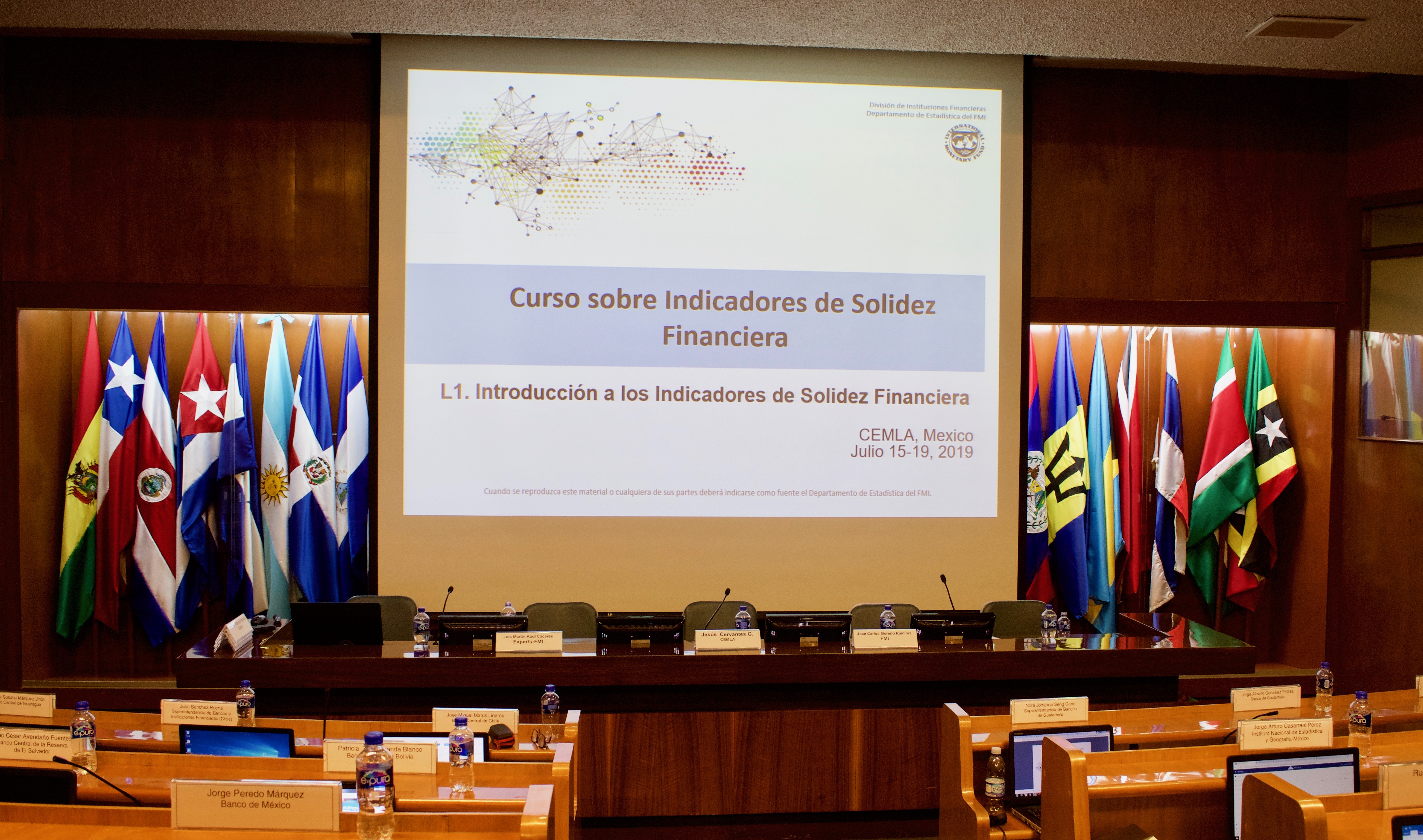Indicadores de Solidez Financiera
Del 15 al 19 de julio de 2019, Ciudad de México, México
El curso sobre Indicadores de Solidez Financiera (ISF) se llevó a cabo del 15 al 19 de julio de 2019, en la sede del CEMLA en la ciudad de México y fue organizado conjuntamente por el Fondo Monetario Internacional (FMI) y el CEMLA. El curso fue impartido por José Carlos Moreno, Economista Senior de la División de Instituciones Financieras del Departamento de Estadísticas del FMI y por Luis Martín Auqui, consultor del FMI, con amplia experiencia en la supervisión de las instituciones financieras.
En general, la evolución de la economía mundial, la creciente integración financiera y comercial de los países, la consecuente mayor interdependencia entre las economías, y la mayor sofisticación de las transacciones que se llevan a cabo en los mercados financieros, han implicado la necesidad de que los bancos centrales y las superintendencias cuenten con nuevas estadísticas e indicadores. En particular, la crisis financiera internacional que comenzó en 2007-2008 y la difícil situación que enfrentó la economía mundial en los años subsecuentes incrementaron la importancia de que toda esa información económica sea precisa, comprensiva y oportuna.
Hacia finales de la década de los noventa el FMI lanzó el esfuerzo de recolección de datos denominado Indicadores de Solidez Financiera, que perseguía darle seguimiento a la solidez del sistema financiero de los países desde una visión macro-prudencial y , en 2006, se publicó la Guía de Compilación de los Indicadores de Solidez Financiera ( 2006 Guide). No obstante, la crisis financiera global de 2007-2008 hizo evidente la urgencia de contar con indicadores adicionales para fortalecer la vigilancia macro-financiera. Lo anterior se incorporó en la “Data Gaps Initiative (DGI)” que fue apoyada por el G-20.
En este contexto, el objetivo del curso sobre ISF fue mejorar la capacidad de los bancos centrales y de las superintendencias financieras de los países de la región de América Latina y el Caribe para compilar los ISF. Tales indicadores sirven el propósito de que los bancos centrales y las superintendencias financieras cuenten con información estadística que les permitan evaluar correctamente la situación general de la economía en su conjunto, la de las instituciones y mercados financieros y llevar a cabo análisis macroprudencial. Los ISF permiten evaluar la solvencia, fortalezas, riesgos y vulnerabilidades del sector financiero en su conjunto y de sus distintos segmentos y tienen la ventaja de que son comparables entre países. De esa manera, contribuyen al diseño de medidas de política monetaria y financiera que sean adecuadas y efectivas, enfocadas al logro y sostenimiento de la estabilidad financiera y, en general, de la estabilidad económica.
El curso resumió en una semana los aspectos conceptuales, metodológicos, de medición y los analíticos o de interpretación de toda la gama de indicadores de solidez financiera, tanto de aquellos que ya se le reportan periódicamente al FMI, como de una diversidad de nuevos indicadores que se persigue instrumentar. Un componente del curso fueron los ejercicios prácticos de medición y de evaluación de estos indicadores. En el curso también hubo diez breves presentaciones de los participantes sobre los avances en sus países en la instrumentación de los ISF.
Un aspecto importante del curso es que se basó en la Nueva Guía de Compilación de los Indicadores de Solidez Financiera de 2019 (2019 Financial Soundness Indicators Compilation Guide) que prácticamente acaba de ser liberada y que está en las etapas finales de su revisión editorial. La nueva guía amplía el número de ISF para incrementar la cobertura del sector financiero, incluyendo a otros intermediaros del sector financiero, a los fondos del mercado de dinero, a las compañías de seguros, a los fondos de pensiones, a empresas no financieras y a los hogares.
Administrative Briefing
CEMLA Staff
Introduction to Financial Soundness Indicators (FSIs)
- This lecture provides background of IMF’s work on FSIs and discusses the structure and main topics to be covered during the course.
Institutional Sectors and Financial Markets
- This lecture focuses on the concepts of residency, characteristics of institutional units (IUs), and their grouping into institutional sectors (ISs), providing a building block for compiling macroeconomic statistics, including FSIs.
- Participants are expected to learn how to classify IUs into the different ISs based on their functions.
- Participants also learn the specificities of different financial markets and the main players therein.
Workshop: Sectorization of Financial Institutional Units
Consolidation Basis
- This lecture focuses on the concepts of control and group consolidation for compiling FSIs.
- Participants are expected to be able to identify reporting populations based on the different consolidation bases for building FSIs.
- Participants are expected to understand the importance of selecting an appropriate consolidation basis for compiling FSIs for their countries and implications for cross-country comparability.
Workshop: Reporting Population for Different Consolidation Basis
Regulatory Framework for Deposit Takers
- This lecture discusses the main regulatory principles for deposit takers under the different Basel Accords.
- The focus will be on capital requirements, leverage and liquidity.
- Participants are expected to understand the core principles of Basel I, II, and III and their implications for FSIs.
Workshop: Basel Regulatory Framework
Accounting Principles for FSIs
- This lecture discusses the financial instruments, income and expense items presented in the FSI reporting templates and the accounting rules underlying their calculation, which broadly defer to IAS/IFRS.
- Participants are expected to learn how each category of assets, liabilities, and income/expense items is recognized, revalued, and presented.
Sectoral Financial Statements for FSIs
- This lecture discusses source data for compiling FSIs with focus on the sectoral balance sheet and income statement from which FSI underlying series are derived.
- Participants will familiarize with the formats of the sectoral balance sheet and income statement for different sectors and definition of each category of assets, liabilities, and income/expense items.
- With this understanding, participants will be able to map their source data to the FSI templates or review and improve their existing FSI compilation framework. Financial statements for nonbank sectors are also introduced.
Core FSIs for Deposit Takers
- This lecture discusses the 12 core FSIs for deposit takers focusing on their calculation, source data, and analytical value from the financial stability perspective.
- Participants will have better understanding of how each core FSI is constructed and potential data issues associated with its calculation. This will help them identify areas for further improving their current compilation practice.
- In addition, participants are expected to know better how to analyze and interpret FSIs to assess the strength and vulnerability of their financial system.
Additional FSIs for Deposit Takers
- This lecture discusses the 13 encouraged FSIs for deposit takers focusing on their calculation, source data, and analytical value from the financial stability perspective.
- Participants will have better understanding of how each of these FSIs is constructed and potential data issues associated with its calculation. This will help them identify areas for further improving their current compilation practice.
- In addition, participants are expected to know better how to use the encouraged FSIs to support the interpretation of the core FSIs in assessing the strength and vulnerability of their financial system.
Additional FSIs for Other Financial Corporations
- This lecture discusses the FSIs for other financial corporations focusing on the existing two FSIs to assess the importance of this sector and new FSIs included in the modified list.
- Participants will be familiarized with the calculation methods and the interpretation of the existing FSIs.
- The significantly revised framework for FSIs covering the nonbank financial sector will be discussed and this will serve as a heads-up for their FSI work program going forward.
Additional FSIs for Nonfinancial Corporations and Households
- This lecture discusses the existing FSIs as well as new FSIs for nonfinancial corporations and households focusing on their calculation, source data, and analytical value from the financial stability perspective.
- Participants will be familiarized with the calculation methods and the interpretation of the FSIs, which serve as leading indicators for deposit takers’ health and soundness.
- Participants are expected to understand better how useful these FSIs are in the assessment of the strength and vulnerability of their financial systems and make greater efforts to compile more FSIs for these sectors.
Workshop: Production of Sectoral Financial Statements and Compilation of FSIs for Deposit Takers
Group Presentations by Participants
Compilation and Dissemination of FSIs
- This lecture discusses practical issues related to the compilation and dissemination of FSIs with focus on coordination and responsibility of different relevant agencies.
- Participants will be familiarized with managerial and strategic issues that need to be addressed to ensure smooth data sharing among relevant units and FSIs are compiled and disseminated in a timely manner.
Closing Session and Presentation of Certificates
- Financial Soundness Indicators Compilation Guide ![]()
- Introduccióna los Indicadores de Solidez Financiera ![]()
- Sectores Institucionales y Mercados Financieros ![]()
- Marco Regulatoriopara las Institucionesde Depósito ![]()
- Principios Contables para el Cálculo de Indicadores de Solidez Financiera ![]()
- EstadosFinancieros Sectorialespara la Compilaciónde los ISF ![]()
- Indicadores de Solidez Financiera Básicos para Instituciones de Depósito ![]()
- Indicadores de Solidez Financiera Adicionales para Instituciones de Depósito ![]()
- Indicadores de Solidez Financiera Recomendados para las Otras Sociedades Financieras ![]()
- Indicadores de Solidez Financiera recomendados para Sociedades no Financieras y Hogares ![]()
- Mercados Inmobiliarios e ISF ![]()
José Carlos Moreno Ramírez,
Economista Senior de la División de Instituciones Financieras del Departamento de Estadísticas del FMI
Luis Martín Auqui Cáceres
Consultor del FMI, con amplia experiencia en la supervisión de las instituciones financieras.





